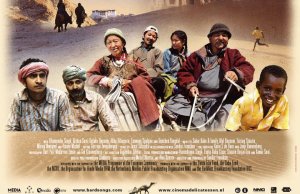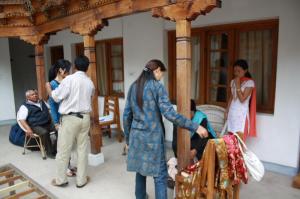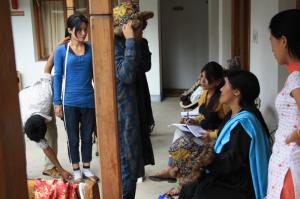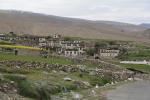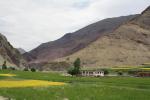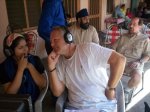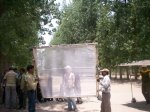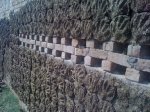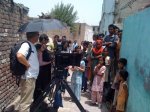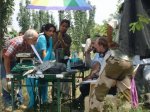Every film comes with an enriching experiences. No film can be same. No crew can be same. With every film we learn or unlearn. We meet new people and build new relationships. In this space I share my personal experiences on different films. Some of the entries may just be informative, while some may give an overview or just give a record of what happened on a particular day of shoot.
A Paper on Ritwik Ghatak
17 05 2010I had written this during my college days. Found it on a CD. I thought it would be appropriate to put it here:
The objective of this paper is to give a brief description of Ritwik Ghatak’s life and draw a parallel between Ritwik Ghatak’s film Meghe Dhaka Tara (A Cloud Capped Star) and the political and social scenario in India and Bangladesh during that Period.
Ritwik Ghatak: The Legend
Ritwik Ghatak was born in 1925 in Dhaka, then a part of India, but in 1947, after the independence and partition of India, it became a part of East Pakistan and now it is the capital of Bangladesh (after the partition of Pakistan in 1972). Ghatak moved to Baharampur and then to Calcutta in the early fifties. Ritwik Ghatak was moved by this partition and this fact is quite evident in his films. He is amongst those directors in the world who have left a mark in the world cinema. Though he was an alcoholic and used to stay drunk even during work, he made all his films with a passion which is quite rare in today’s world. He made sure that he made his statement through his films.
He had a charm of getting the students he taught and the filmmakers he knew immediately on his side. This made him an admirable and an extraordinary man. And even though he was clearly an alcoholic, they seemed to try to protect him in every way.1
He started his career by joining the Indian People’s Theatre Association (IPTA) which was a communist group. He himself was a firm believer of Marxism. He directed and acted in plays. He also translated Brechtian2 plays and then directed them. He soon realized that he was not able to get his message through the masses, so he decided to make films.
He died in the year 1976, leaving many project unattended and incomplete.
Style of Filming:
Ghatak was influenced by the arguments that Sergie Eisenstein, the Russian filmmaker and Rabindranath Tagore, a poet and a Bengali writer put across. He was not influenced by Hollywood or the French New Wave Cinema but like Jean-Luc Godard, who was obsessed by the Vietnam War, Ghatak was obsessed with the Bengal Partition.1
Ghatak’s involvement with literature is also quite evident in his films. In Meghe Dhaka Tara (A Cloud Capped Star), he has referred to Tagore, Yeats, Keats and Wordsworth. In fact the title, ‘A Cloud Capped Star’, is taken from a speech by Prospero, a character in Shakespeare’s The Tempest.
He made some of his films under the influence of alcohol, but he made them with great passion. His films were sometimes overemphasized, sometimes melodramatic, sometimes unevenly edited, but there was an enormous power in his films which transcended everything else.1
He also tried new techniques which had never been used in the Indian cinema. Foe example the use natural sounds which are very prominent in the film, Meghe Dhaka Tara.
Statement through Films:
Ritwik Ghatak was deeply moved by the Partition of Bengal, and the statement that he tried to make through his films was about how terrible the process of partition was.
“Being a Bengali from East Pakistan I have seen the untold miseries inflicted on my people in the name of independence – which is a fake and shame. I have reacted violently to this and even in my last film, which is yet to be released (Jukti Takko O Gappo) I have tried to portray different aspects of this. I am also aware of a complete break-down of moral values around me especially among the younger generation of today.” 4.
He also believed that the bourgeoisies had done this to themselves. The British alone could not be blamed for the partition of India; the Indians themselves were at fault. This is one reason why we can see the main characters of his films as refugees belonging to the bourgeois class.
A Glimpse on Ghatak’s Works: 5
Bedeni, was Ghatak’s first directorial venture which he took over from another director, Nirmal Dev, but it remained unfinished. Ritwik’s first complete film was Nagarik. Shot and edited in 1952-53, the film was ultimately to be released in the late seventies. This film deals with the partition of Bengal and the life of the refugees. In the end of the film, Ramu, the protagonist, abandons his house and his individual aspirations to join a political struggle for equality between classes. It was during this period (1952 – 53) that the Language Movement was at its peak and that thousands of students had already laid down their life for getting Bangla approved as a state language. The movement continued till 1956.
The first of his films to be released was Ajantrik in 1957. The film was about the law of life and the life cycle. Bari thheke paliye was made in 1959, based on a children’s story about a little boy who runs away from home in search of adventure. In spite of its occasional brilliance (like the innovative use of low angle and ground shots; influenced by Ozu, a Japanese filmmaker)6. Ritwik does not appear very comfortable in his treatment of child psychology.
His fully developed style could be seen in 1960 with the release of his three films: Meghe Dhaka Tara, Komol Gandhar, and Subarnarekha. While Meghe Dhaka Tara was a success, the others were failures.
On December 16, 1971, Pakistani forces surrendered, and Bangladesh was finally established the following day. The new country changed its name to Bangladesh on January 11, 1972 and became a parliamentary democracy under a constitution.
The following statement made by Ritwik Ghatak, after he finished making Titas Ekti Nadir (1973), can give an overview of his life and his country. “I did not realize that whatever ideas I had about Bengal, the two Bengals together, were thirty years out of date”, he said. “My childhood and my early youth were spent in East Bengal. The memories of those days, the nostalgia maddened me and drew me towards Titash, to make a film on it. The period covered in the novel, Titash, is forty years old, a time I was familiar with…Consequently, Titash has become a kind of commemoration of the past that I left behind long ago…when I was making the film, it occured to me that nothing of the past survives today, nothing can survive. History is ruthless. No, it is all lost. Nothing remains”. In spite of this Ritwik worked passionately on the project struggling with tuberculosis along the way.5.
Meghe Dhaka Tara (A Cloud Capped Star)
At first sight, Meghe Dhaka Tara, is a traditional melodrama, even though the characters posses an intense psychological density and the film a realistic dimension.
The film was inspired by a girl on a bus stop. Ghatak looked at the girl and questioned himself about the state of the women in Bengal. How many such women exist in Bengal, who live an impoverished life and stand to support their family? This fact is emphasized many a time in the film. In the end, when it is revealed that Neeta, the heroine of the film, is going to die, another girl is shown whose circumstances match that of Neeta’s in the beginning of the film (i.e. she is poor and earns money to support and hold her family together). And this is the reason why the girl on the bus stand was the heroine of the film. The story is about the girl who sacrificed everything just to keep her family together. The greater effort the girl made to keep the family together that much more pain, lonely and isolated she got.
In the opening sequence, across a river, a train is shown moving from the right of the frame to the left. This sequence of the train is repeated many times during the film. This train is used to signify the distance in relationships and the distance between the two countries created by partition.
The landscapes also play an important role in the film. The other motifs of Nita are the tree and water, the ancient images for Prakriti. While tree provides shelter and refuge, water has been always been associated with the primal force of creation.7 The establishing shot of the film is that of a pond and a tree. It is interesting that whenever Shankar, Neeta’s brother, does his morning ‘riyaaz’ and sings to the Great Mother, Neeta passes by from below the tree.
One cannot overlook the technical aspect of the film. The use of natural sounds, like the chirping of the birds and crickets are exceptional. Special sound effects like the sounds of the whip, to depict uneasiness in the state of mind, create an entirely different aura about the situation Neeta is in. Certain sounds even hold metaphorical significances, like the sound of the boiling rice and the mother getting angry and jealous. The building up of the uncanny music and the use of non-diegetic sounds; be it the sound of the whip or the school children reciting their table, all of them, together, help to bring out the melodramatic feel of the film.
The characters in the film are refugees belonging to the bourgeois class. Education is the top priority at this period, this can be seen throughout the film. Factory jobs are looked down upon, this is quite evident by the reaction of the father when Montu, Neeta’s younger brother, gets a job in a factory because he is a sportsman. The father says, “See what the middle classes have sunk to.”
Ghatak always believed that the people of India were equally to be blamed for the partition and the effects of it. And he projects this by stating that the biggest sin is to not protest against any injustice. This comes out when Neeta makes a conversation with Sanat; Neeta says that I need to go in penance because I have not stood up against injustice.
Many references have been made regarding the cultural development and progress. People are making efforts to hold plays and spread messages. Moreover, there is also the depiction of partiality towards the sons. Neeta is the bread earner of the house. She earns money and spends it on her siblings. Her mother scolds her for wasting money. But after a few months, Montu starts earning money she allows him to live and eat in a hostel provided by the factory. Her mother is selfish, as she wants Neeta to sacrifice her needs and keep earning money to provide for the family. Neeta’s mother also encourages Gita, Neeta’s younger sister, to flirt with Sanat, Neeta’s lover. Eventually Sanat leaves his research, takes a job and marries Gita.
To depict the moral and social degradation of the post independent Bengal, Ghatak makes use of Indian myths and archetype. Neeta is not only emotionally and physically sacrificed by their families but are also symbolically sacrificed as goddesses. As symbolic goddesses, Neeta represents the land of Bengal and it is Bengali society that sacrifices Her with division and greed. In Meghe Dhaka Tara, the character Neeta is actually the manifestation of multiple goddesses: Durga as Jagadhatri, the benevolent image of the eternal giver and universal sustainer, and Uma, the Mother Goddess.
Ira Bhaskar represents the manifestation of Durga in her essay, ‘Myths & Ritual’: “A prevalent story about the genesis of Durga is the concept of Havyagni (oblation to the sacrificial fire). In the ritual of the Havan (the act of consigning the mortal offering to the sacrificial flames) is symbolized the surrender of human desires and aspirations which are carried to the heavens with the smoke. It is believed that Durga was born out of this smoke as a transmutation of human desires, taking the form of Jagadhatari, the universal sustainer. One of the central images associated with Nita is the courtyard wherein are centered the ambitions of the rest of the family… These selfish ambitions pour into the courtyard, the symbolic yagna mandapa, from which manifests Nita in the role of the Provider and Creator.” 7
This aspect is very clear through the lyrics of the song:
Come, my daughter Uma, to me.
Let me garland you with flowers.
You are the soul of my sad self, Mother, the deliverer.
Let me bid you farewell now, my daughter!
You are leaving my home desolate, for your husband’s place.
How do I endure your leaving, my daughter?
This song also emphasizes the fact that Neeta has been used merely as an object that earns money for the family, and after her utility is over, she is of no use and hence is sacrificed. Her father asks her to leave the house because she is going to become a burden for her siblings.
There are lines by Tagore which have been used to make a statement on the independence that was followed by the partition.
The night the storm blew open my door,
Little did I know that you would come in,
Everything went dark, the lamp dimmed,
I reached up to the heavens not knowing why,
In darkness I lay dreamy.
Could I know that the storm was the prurient of your triumph?
In the morning did I see: You standing there:
Standing in what was an empty room.
If one looks from a different angle, things may seem to become a bit clear. Neeta is the representation of our country, which is poor and trying to hold together but how hard it tries to keep things together (by partition and agreements), it isolates and causes pain to itself. India and Neeta both want to live as they are young and have a lot in store for the future, but then both of them have been poisoned, one by bloodshed, the other by tuberculosis.
Conclusion:
Though Ritwik Ghatak did not get his due recognition during his lifetime, the statements made by his films are so profound and his filmmaking style so unique, that he will be remembered by the generations to come.
References:
1. Derek Malcolm (film critique) on Ritwik Ghatak.
2. Brechtian: Bertolt Brecht, a famous German dramatist & stage director.
3. ‘Woman’ and ‘homeland’ in Ritwik Ghatak’s films: An Essay by Erin O’Donnell
4. Excerpt from Kalpana Biswas’ interview with Ritwik Ghatak.
5. Taken from http://www.onmag.com/ritwik.htm
6. Inputs by Dr. Madan Gopal Singh.
7. Journal of Arts & Ideas: Issue3, 1983: ‘Myth & Rituals’ by Ira Bhaskar
8. ‘The Cinemas of India’ by Yves Thoraval

A Paper on Ritwik Ghatak by Mukul Khattar is licensed under a Creative Commons Attribution-Noncommercial-No Derivative Works 2.5 India License. Based on a work at myfilmcareer.wordpress.com.
Comments : Leave a Comment »
Categories : Uncategorized
Heart Land: It’s all over.
15 06 2009Finally, the shoot went off well despite all the problems. When I look back at it, it was a party with a few spoilers. Moreover, I made new friends and got to learn a lot. And that’s the most important thing.
The last few days were hectic enough for me not to get time to write my posts. Eventually, things went off well. The end result was good. There was a bit of confusion and fights regarding the payments. We were not paid 2 days before the shoot, but after the complete shoot – the day we were suppose to leave for Delhi. The money was transferred to our bank accounts and a confirmation code was given.
By the end of the shoot there was a bond between the American Crew and the Indian Crew. There was a party everyday, thanks to Siddharth, Urvashi & Vincent.
Things started badly and everything looked messed up. Some of us had problems with Sunny but even that got sorted. He was just misunderstood by almost everyone. What is most important is that by the end everyone was happy and content with the work done. There were no hard feelings for anyone. And, I got a 50% bonus.
The objective of me writing this blog is to share my experiences with my family and friends. After all I hardly get to see them. These posts potray my feelings and my conclusions at the time of writing. I do not intend to praise or condemn anyone. And, if I have, I am sorry but that’s how I feel and communicate.
Some working stills from the production:
- Sound Department at Work
- Pretending to Work: Aakriti & Paul
- Vincent behind the Screen
- Close to Vincent’s Special Place
- Crowd management
- Serious Discussion
- What’s the next shot?
Comments : Leave a Comment »
Tags: Heart Land, last day, Payments
Categories : Feature Films, Heart Land
